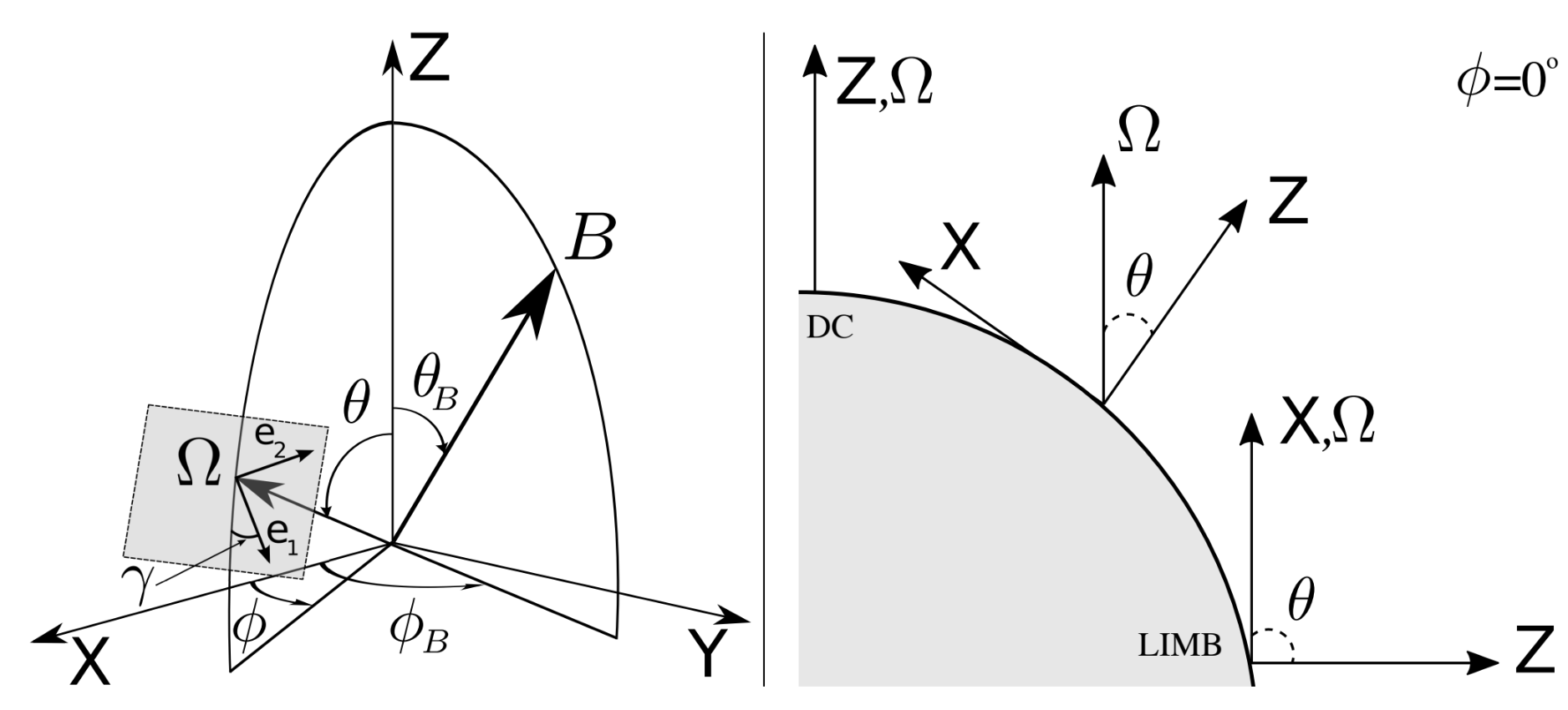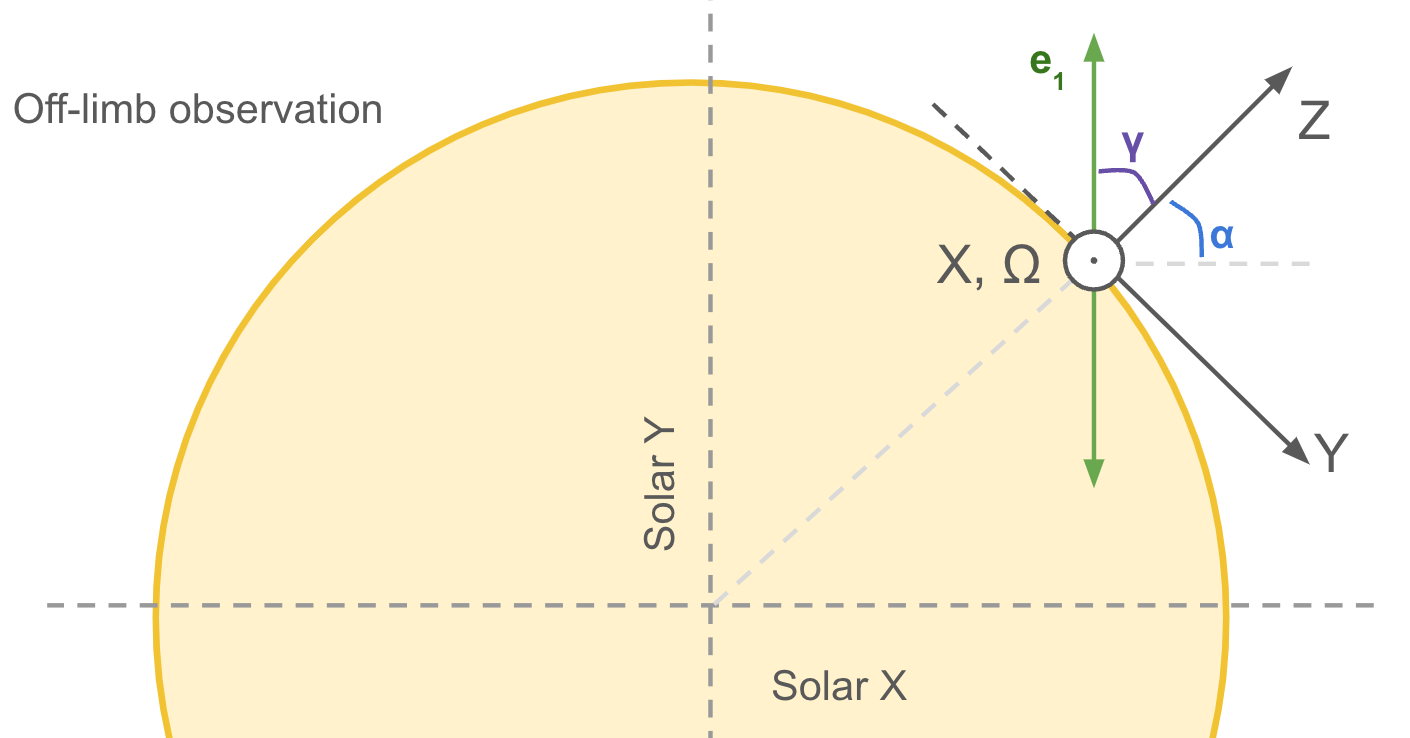5.6. The reference system¶

Left) reference system used in Hazel. Right) configuration of the reference system choosing \(\chi=0\) and for different values of \(\theta\).¶
We show in Fig.1 the reference system used in Hazel. The capital letters \(X\), \(Y\) and \(Z\) are the reference directions in the local frame, with \(Z\) pointing in the direction of the local vertical, and \(X\) and \(Y\) in the local horizontal plane parallel to the solar surface. The vector \(\Omega\) is pointing in the direction of the observer and the plane perpendicular to that vector (where \(e_1\) and \(e_2\) are defined) is the plane of the sky. The vector \(\Omega\) is defined by two angles: \(\theta\) and \(\chi\). The angle \(\theta\) is the heliocentric angle, which is the angle between the vector \(\Omega\) and the local vertical. The angle \(\chi\) is the azimuthal angle, which is the angle between the projection of the vector \(\Omega\) in the local horizontal plane and the local X direction. The magnetic field has its own reference system, defined by the angles \(\gamma_B\) and \(\phi_B\) measured from the local X and Z directions, respectively.
For off-limb observations, we have \(\theta = 90\), while for observations on the solar disk, we have \(\theta < 90\). Without any lack of generality and for simplicity, \(\phi\) is generally taken to be 0 so that the LOS vector is contained in the Z and X plane. For example, if \(\phi = 0\) is chosen in an off-limb observation the \(\Omega\) vector lies along the X axis, while for on-disk observations \(\Omega\) lies somewhere between the Z and X axis, i.e., the projection of the X axis in the plane perpendicular to the LOS points towards the disk center (see right panel of Fig.1). We could also choose \(\chi= 180\), then \(\Omega\) is between \(Z\) and \(-X\). However, for simplicity, we choose \(\chi= 0\) unless we have a good reason to do it. The angle of the reference of the polarimeter is indicated with the angle \(\gamma\) and it is measured from the local Z.
5.6.1. On-disk observation¶
Let’s consider an on-disk observation with location \((x,y)\): (-300,-200) arcsec where the reference of the polarimeter (Q>0) is aligned with the solar N-S direction. As mentioned before, we choose \(\chi= 0\) for simplicity. This means that the LOS is in between the Z and X axis, and the X axis is pointing towards the disk center. The angle \(\gamma\) is measured from the plane X-Z towards the \(e_1\) direction. Let’s calculate the angles for this observation. A sketch of the reference system is shown in the following figure:

We start calculating the heliocentric angle:
theta = arcsin(sqrt(x**2.+y**2.)/960.)*180/pi = 22.1d
Then we can calculate the angle from the solar equator:
alpha = arctan(y/x)*180./pi = 33.7d
Now we can calculate \(\gamma\) (must be measured from X to Y, anticlockwise). In this case, \(\gamma\) gives:
gamma =(90 - alpha) = 56.3d
Then, the angles for this observation are:
theta_OBS = 22.1d
chi_OBS = 0.0d
gamma_OBS = 56.3d
5.6.2. Off-limb observation¶
Let’s consider an off-limb observation with location \((x,y)\): (+750,+600) arcsec where the reference of the polarimeter (Q>0) is aligned with the solar N-S direction. As mentioned before, we choose \(\chi= 0\) for simplicity. A sketch of the reference system is shown in the following figure:

In this situation, the observations are at the limb, and as a consequence of choosing \(\chi= 0\), the X axis is pointing towards the observer parallel to the LOS. As in the previous example, the angle \(\gamma\) is measured from the plane X-Z towards the \(e_1\) direction. We follow the same procedure as for the on-disk observation. First, we calculate the heliocentric angle:
theta = arcsin(sqrt(x**2.+y**2.)/960.)*180/pi = 90.0d
Then we can calculate the angle from the solar equator:
alpha = arctan(y/x)*180./pi = 38.7d
So the angle \(\gamma\) gives:
gamma =(90 - alpha) = 51.3d
Then, the angles for this observation are:
theta_OBS = 90.0d
chi_OBS = 0.0d
Gamma_OBS = 51.3d